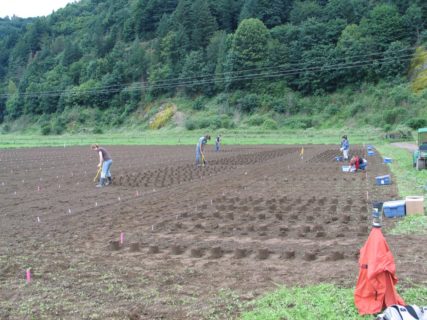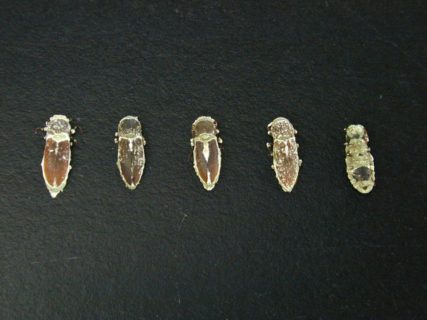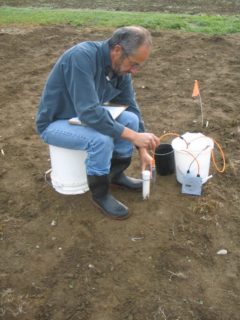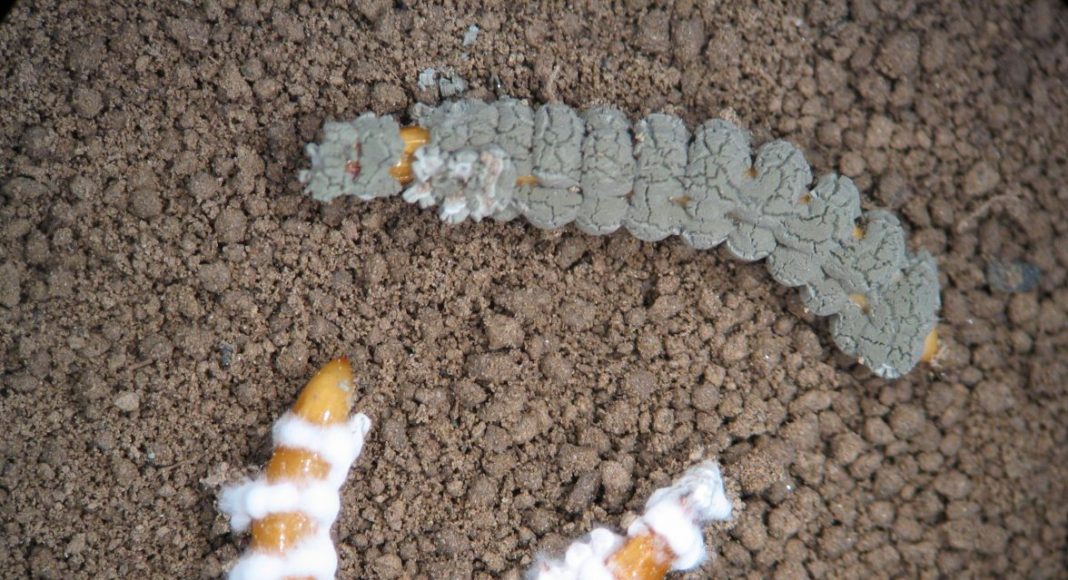[deck]A promising biopesticide is in the works for managing wireworms.[/deck]
A few years ago, Todd Kabaluk was given some fuzzy wireworms. That might not sound like an auspicious gift, but Kabaluk is a research biologist in integrated pest management with Agriculture and Agri-Food Canada (AAFC). He was immediately interested. As it turned out, these fuzzy wireworms were the first step on the path toward a new possibility for controlling wireworms.
Wireworms are the tough-to-control, soil-dwelling larvae of click beetles. AAFC has found that Canada has about 20 or more wireworm species of economic importance. Some are native to Canada, while others are invasive species from Europe. The various species can differ from each other in ways that influence the effectiveness of different control practices.
Wireworms feed on the underground parts of plants and can cause serious damage in many crop types. The larvae live in the soil for several years, growing bigger each year. At the end of the larval stage, they pupate and emerge from the soil as beetles to mate and lay eggs.
In potatoes, wireworms tunnel into tubers, reducing marketable yields and providing entry points for disease. They are estimated to cost Canada’s potato industry millions of dollars each year in crop damage and control measures.
“The number of effective chemical pesticides for wireworm control in North America and Europe has been decreasing over the past few years. Having any new pesticide, whether it be chemical or biological, would help farmers,” says Kabaluk.
“Biopesticides are generally regarded as safe in terms of human and environmental health. They are often suitable for organic agriculture. Providing organic growers with a means to control wireworms is so important because, in Canada at least, they have no registered wireworm control products available to them.”

Photo: Todd Kabaluk/AAFC
Kabaluk isolated the fungus from the fuzzy wireworms and determined that it was Metarhizium brunneum. It was this virulent strain of Metarhizium brunneum that gave the wireworms their fuzzy appearance after the insects were infected by the fungus. Kabaluk then infected some wireworms with the isolate and confirmed it was the cause of the same disease exhibited by the fuzzy wireworms.
“Metarhizium is an insect fungal pathogen quite commonly found infecting insects in nature,” he says. “Unique strains have been discovered and developed for commercial use to control various agricultural insect pests.”
Kabaluk’s initial tests showed the strain he discovered, called Metarhizium LRC112, is very virulent to several wireworm species. He and his research group are now in the process of testing LRC112’s effects on Canada’s many pest wireworm species.
“This particular strain has turned out to be the most virulent of any Metarhizium strain I’ve tested,” he says. “It is especially virulent toward all three European wireworm species invasive to Canada: Agriotes obscurus, Agriotes lineatus and Agriotes sputator. All three, particularly Agriotes sputator, are serious pests of potato in Prince Edward Island. Agriotes obscurus and Agriotes lineatus are the most serious pest species in southwestern British Columbia. Metarhizium LRC112 is also virulent toward other indigenous pest wireworm species.”
Kabaluk’s group produces its own LRC112. “We mass-produce Metarhizium in our lab, with my technician Beth McCannel being the mass production specialist. We follow a production method that is well known to insect pathologists, but tricky. It involves growing specialized fungal structures in a nutrient-rich liquid solution under sterile conditions, then using the resulting fungal broth to inoculate sterile grain, preferably rice. The fungus uses the carbohydrates in the grain as food, and produces the spores that are infectious to wireworms. We can use the rice granules as the control product itself, or extract the spores to formulate with other carriers for application.”

Photo: Todd Kabaluk/AAFC
An important challenge for Kabaluk is to develop practical, affordable and effective ways to deliver the fungus to the pest. “There are several ways to deliver Metarhizium LRC112 to its targets — wireworms and click beetles,” he says.
“For wireworms, we apply the fungus with a substance that produces carbon dioxide. Carbon dioxide is a powerful wireworm attractant. In nature, it is produced by plant roots and helps wireworms locate the plant root food source. There are many other substances that emit carbon dioxide — rolled oats, for example.”
When the researchers apply the Metarhizium granules plus rolled oats to moist soil, the carbon dioxide emitted from the rolled oats attracts the wireworms to the fungus and they become infected.
Kabaluk also says his colleagues Stefan Vidal, with Georg-August University, and Anant Patel, with the University of Applied Sciences in Germany, have created a very sophisticated granule that is a carbon dioxide-producer and Metarhizium carrier all in one. “It is called Attracap and sold by the German company Biocare. It can be very good at attracting and killing wireworms and protecting potatoes from wireworm feeding damage.” Attracap uses a different strain of Metarhizium brunneum.
Kabaluk’s group is currently experimenting with a variety of attract-and-kill application methods for wireworm control in potato and field vegetable crops, comparing several carbon dioxide-producing options such as rolled oats and Attracap. “At our research centre in Agassiz, B.C., we have some really neat facilities that we use to measure carbon dioxide production of a lot of substances. We use the carbon dioxide production data to choose the substances that will attract the most wireworms.”
To attract click beetles to the fungus, Kabaluk uses pheromones. “Sex pheromones are powerful insect attractants. They are normally emitted by female insects to attract males. Researchers in Hungary have identified and synthesized pheromones from click beetles. These pheromones are ester compounds that happen to be used for other purposes, like creating pleasant scents — the click beetle pheromone esters smell like lemon geranium. Therefore, they are inexpensively purchased from chemical companies,” he says.

Photo: Todd Kabaluk/AAFC
However, the commercial pheromones are only available in liquid form. “As I was trying to find a way to attract the beetles to the Metarhizium granules, I realized I needed the pheromone in a solid, granular form. I worked with a small B.C. company that helped formulate some prototype granules.”
The initial test results were very promising. “When the pheromone granules were applied with Metarhizium granules, click beetles literally ran toward their fatal Metarhizium infection. Eighty percent of click beetles were infected in less than three hours.”
The original company has changed ownership, so Kabaluk is now working with another company to refine the product. They are creating long-lasting, weatherproof granules that can be used with the Metarhizium granules.
In addition, Kabaluk and his AAFC colleague, Wim van Herk, are evaluating whether the pheromone granules could be used to cause mating disruption in click beetles. The testing so far indicates that a relatively high rate of the pheromone confuses the males. “They aren’t able to locate the females, meaning there are no male-female hookups, no mating, no egg-laying, and no new wireworms added to the soil,” says Kabaluk.
“Field tests will determine if we can achieve click beetle mating disruption to a degree that will reduce soil wireworm populations.” If this approach is successful, he expects the company they have been working with will likely have a commercial product on the market within a few years.

Another strategy Kabaluk has been exploring is the possibility of applying the fungus as a spray to control click beetles. The advantage with a spray is that it would directly target both female and male beetles. The pheromones only directly attract males to the Metarhizium granules; females are infected only if they happen to randomly encounter the fungus granules.
As part of their work to develop LRC112 as a commercial product, Kabaluk and his group are evaluating it for possible unwanted side effects. “It is required that any pesticide registered for use in Canada be applied according to the instructions on the product label. The label, if necessary, provides instructions on how to avoid impacts on non-target organisms, human health and the environment, given our understanding of the pesticide at the time of registration,” he explains.
For example, they are assessing LRC112’s impacts on beneficial insects. “We’ve carried out several lab tests to determine the effect of Metarhizium LRC112 on beneficial ground beetles and have not really noticed a repeatable negative effect. Of course, at times, some beetles will get infected. Initially, Metarhizium LRC112 would be formulated as a granule and applied beneath the soil [to control wireworms]. This is not a location where ground beetles would come into contact with the product,” says Kabaluk.
“When we develop it for above-ground use — such as a spray targeting click beetles or with a pheromone to attract click beetles to the fungus granules — we will also expand our testing to determine if ground and flying insects could be affected and, if so, we will develop application techniques to avoid their exposure.”
Looking Ahead
Considering the next steps in the LRC112 research, Kabaluk says there are always a million research questions to answer and problems to solve. “I think first and foremost, Metarhizium LRC112 needs to be registered as a wireworm active ingredient for use in Canada. To do this, AAFC would license Metarhizium LRC112 to a company, preferably a Canadian company, who would act as registrant and product distributor.”
Registering the strain as an active ingredient will open the door for the creation of commercial products derived from it.
Kabaluk’s group will continue their product development work to move LRC112 toward commercialization. “We feel quite confident in the ability of our test products to kill wireworms and protect crops, but we need to formalize application methods and rates so that they are affordable to farmers. As well, we need to create clear instructions for using the products to ensure efficacy,” he says.
“We will also continue testing the ‘host range’ of Metarhizium LRC112, that is, to determine all the wireworm species it will effectively kill. Knowing this will help us plan its expansion for use with other crops, such as grain crops, also vulnerable to wireworms.”
Another area of investigation concerns how the exposure of click beetles to Metarhizium influences their ability to lay viable eggs. “It takes about eight days for click beetles to start dying of a Metarhizium infection, and during that time they have the opportunity to lay eggs. But perhaps Metarhizium affects this ability in some way. Simon Fraser University graduate student Kari Zurowski is studying this subject and has made good progress in understanding it all.”
If funding becomes available, Kabaluk would also like to further explore why sometimes, mysteriously, Metarhizium applications are not quite as effective as expected. “We’ve found evidence that wireworms can be protected from succumbing to Metarhizium infection by symbiotic bacteria, as is the case for many other insects in resisting disease. I’m curious whether the efficacy of Metarhizium could be improved by applying it with an antibiotic [to kill the symbiotic bacteria].”
Kabaluk’s current Metarhizium LRC112 project is funded by AAFC, many grower associations, small- to medium-sized companies, and farmers, under the Canadian Organic Science Cluster in AAFC’s Canadian Agricultural Partnership Program.











